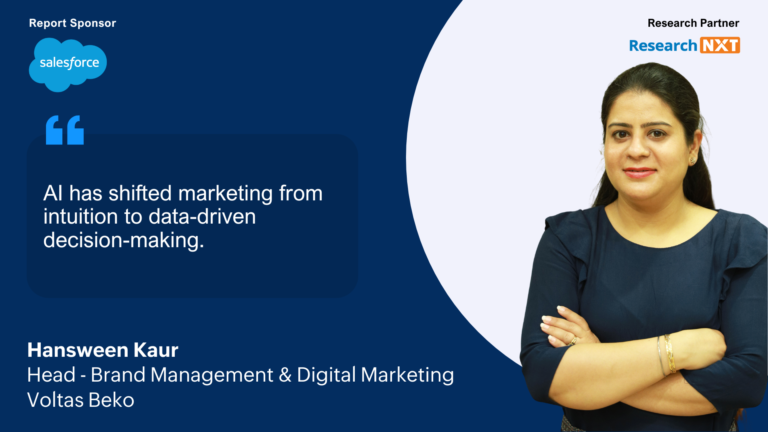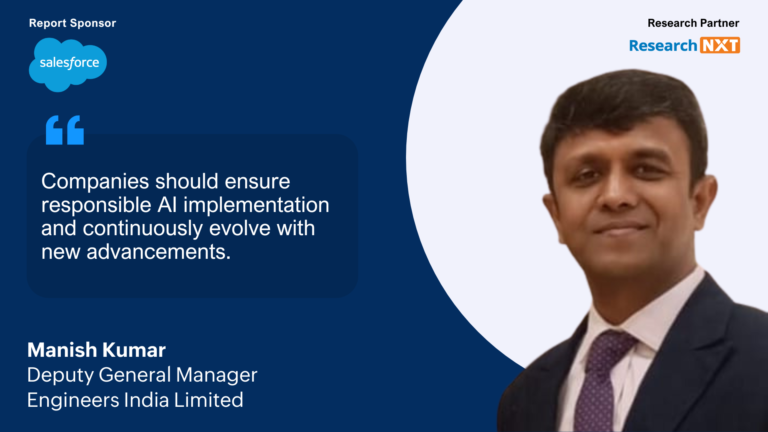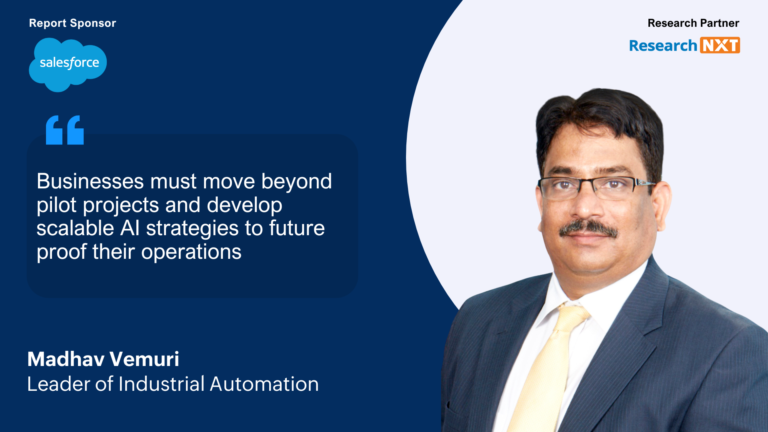
Transforming Global Healthcare: How Apollo Hospitals Leverages AI to Revolutionise Patient Care and International Outreach
Dr. Karthik Anantharaman, Vice President of International Sales & Marketing at Apollo Hospitals, takes us on a journey into the future of healthcare. In an inspiring conversation with Research NXT, he shares his remarkable professional journey and unveils how Apollo Hospitals is revolutionising healthcare through technology. From groundbreaking advancements in diagnostics and patient care to tackling critical challenges like data privacy, Dr. Karthik highlights the role of AI in driving operational efficiency and improving patient outcomes.
Key Highlights from the Interview
- AI in Diagnostics and Chronic Disease Management: AI-enabled tools in diagnostics (e.g., for lung and breast cancer, PET scans) enhance accuracy and treatment planning. In chronic disease management, AI-powered follow-up programs ensure timely diagnostics and care, while tools like PROM integrate patient feedback into care plans for conditions like diabetes and hypertension.
- Real-Time Data Integration for Improved Care: Connected health solutions use AI for real-time data aggregation and remote specialist reporting, enhancing care delivery, reducing hospital stays, and supporting population health management.
- AI-Driven Marketing and Accessibility Innovations: AI supports international healthcare marketing by documenting clinical outcomes and offering customised funding solutions, such as deferred payment plans tailored to patient prognosis, making healthcare more accessible.
- Enhancing Human Expertise with AI: AI should enhance human expertise rather than replace it, with a focus on collaboration, real-time solutions, and aligning AI adoption with clear organisational goals.
- Emerging AI Trends: Promising areas for AI in healthcare include cardiology, stroke management, ophthalmology, oncology, immunology, and transplant medicine. AI-enabled biomarkers and predictive diagnostics are paving the way for personalised medicine and improved treatment outcomes.
- Purpose-Driven AI Adoption: AI adoption should be guided by clearly defined objectives and a focus on delivering meaningful outcomes, rather than simply following trends or fulfilling checklists.
“From a patient experience standpoint, we’ve implemented a system called PROM (Population Reported Outcome Management), which is designed to track and measure patient outcomes after they leave the healthcare facility.”
Please share a brief overview of your professional journey leading up to your current position.
Karthik: Over the course of my career, my experiences have spanned across MedTech, Pharma, and now integrated healthcare services delivery at Apollo. While we initially started as a hospital and caregiver organisation, we have evolved into a fully integrated healthcare company. Today, we are not just a healthcare provider but also a technology enabler, offering a comprehensive tech stack that supports various aspects of healthcare.
Our technology solutions range from basic EMRs (Electronic Medical Records) to advanced AI algorithms for care delivery. These tools are not only used internally but are also offered in a white-label format to other institutions that may lack the resources to develop or implement their own technology. This transformation underscores our shift from being solely focused on patient care to becoming a holistic healthcare service provider.
In terms of my journey, I began in health tech and MedTech, moved into pharma, and eventually transitioned into integrated healthcare services. A significant milestone in my career was my stint at Medlife, particularly during the COVID-19 pandemic. The crisis highlighted the critical role of health e-commerce, allowing us to effectively serve patients during lockdowns through technology-driven solutions.
Following Medlife’s acquisition by another organisation, I transitioned into my current role, continuing to focus on innovation and integration in the healthcare sector. This journey has been both dynamic and rewarding, offering diverse experiences and opportunities to contribute meaningfully to the healthcare ecosystem.
Could you share insights into your key responsibilities and what areas you’re currently focusing on in your functions?
Karthik: In my current role, I oversee several key functions aimed at expanding and enhancing our healthcare services globally:
- Establishing Healthcare Institutions Internationally: We collaborate with local partners, clients, or organisations to set up and operate healthcare facilities. These range from hospitals and diagnostic centres to pharmacy chains or a combination of these. Our role extends from operational planning to managing the healthcare institution effectively under a registered legal entity.
- International Patient Services and Medical Value Travel: Many countries face challenges in accessing high-quality, affordable healthcare, particularly for tertiary and quaternary care. We address these gaps by offering competitive secondary care and advanced tertiary care programs. India has emerged as a global hub for medical value travel, and our institution is a significant contributor to this. Patients from emerging economies and developed nations, including the US, UK, Canada, and Singapore, choose us for our differentiated value proposition—competitive pricing, instant appointment scheduling, and clinical excellence. The expertise of our medical team, including many doctors trained abroad who have returned to India, strengthens our global reputation.
- Digital Patient Engagement and Business Development: With the increasing reliance on digital platforms, we have established a robust online presence. Through SEO and SEM-led campaigns, we attract patients searching for advanced medical treatments online. Our digital customer relationship management team provides counselling, facilitation, and hand-holding to ensure patients receive seamless care at our network hospitals.
These initiatives collectively position us as a leader in international healthcare, advancing our mission to make high-quality medical care accessible worldwide.
Read More
Having spent much of your career in the healthcare industry, how do you see technology, particularly AI, shaping the sector and influencing its evolving dynamics?
Karthik: In my current role, we leverage technology, particularly AI, to drive advancements in diagnosis, treatment, and patient management. Let me break this down into three core areas:
1. Advancing Diagnostics with AI
We are running three key programs aimed at improving diagnostic accuracy and efficiency:
- Lung Cancer Diagnosis (LDCT Program):
Using high-resolution CT scans, AI compares patient images with a database of confirmed lung cancer cases. This enables highly accurate, data-backed diagnoses by differentiating lung cancer from other conditions like pneumonia or lung cysts. - Breast Cancer Detection:
Advanced AI algorithms help identify and distinguish breast cancer from non-cancerous conditions. This technology, deployed across Apollo Cancer Center networks, has significantly improved early detection and treatment planning for breast cancer. - Digital PET Scan Diagnostics:
PET scans, a critical tool in cancer diagnosis and treatment planning, are enhanced by AI to provide precise insights into cancer staging and treatment options. This ensures accurate diagnostic results, further aiding clinical decision-making.
2. Connected Health Across Specialties
Beyond oncology, our connected health suite spans cardiology, critical care, transplant medicine, and more. This modular and scalable solution allows hospitals globally to connect with expert specialists remotely. Features include:
- Integration of devices from ICUs, OTs, and imaging centres (digital X-rays, ultrasounds, CTs, MRIs).
- AI-enabled aggregation of images in various formats for instant specialist reporting.
- Improved patient management through real-time insights, ensuring better clinical outcomes.
By leveraging these solutions, we aim to reduce hospital stays and accelerate patient recovery. These measurable outcomes serve as key indicators of the success of our technological interventions.
3. Managing Chronic Diseases with AI-Driven Follow-Ups
Chronic conditions such as diabetes, hypertension, thyroid disorders, and cancer require lifelong management. To address this, we’ve developed AI-powered follow-up programs:
- Automated reminders for patients to undergo periodic diagnostics and consultations.
- Appointment scheduling based on discharge summaries or medical advice plans.
These systems ensure timely care, helping patients maintain control over their conditions and improving their quality of life.
Our technology initiatives focus on tangible improvements in patient outcomes, such as reduced hospital stays and faster recovery times. These hard endpoints, along with comprehensive documentation, allow us to assess the real-world impact of these innovations on patient care.
By integrating advanced AI and tech-driven solutions across our healthcare ecosystem, we are not only enhancing diagnostic accuracy and treatment planning but also ensuring holistic, patient-centred care.
From a patient experience perspective, are there additional areas beyond the ones you’ve already mentioned where you see AI making a significant impact within your system?
Karthik: From a patient experience standpoint, we’ve implemented a system called PROM, which stands for Population Reported Outcome Management. PROM is designed to track and measure patient outcomes after they leave the healthcare facility, whether as outpatients following a consultation or as inpatients who were admitted, treated, and discharged.
This system is integrated into the Apollo 24/7 app, a popular platform that allows patients to report any new benefits or side effects they notice after returning home. It also enables them to update their doctor about their general clinical condition, how they’re responding to prescribed medications, and the overall effectiveness of the advice provided during their consultation. Patients can record this information in their own words, and it becomes part of their Personal Health Record (PHR). The PHR is linked to a unique health ID specific to the patient, adhering to strict privacy policies with limited access.
A key feature of PROM is its ability to flag and automatically report critical concerns, such as adverse effects or side effects, to the hospital and the treating physician. This ensures that timely and appropriate actions can be taken to address these issues.
PROM represents a significant advancement in patient care, offering a robust tool to monitor and enhance patient-reported outcomes. Its continued development and refinement will further ensure that patient-level outcomes lead to impactful, timely, and adequate healthcare interventions.
How do you measure the impact of the technology and AI you’ve implemented, particularly from a patient experience and overall outcomes perspective? Have you established specific KPIs to track this impact, and are you at a stage where you can evaluate the ROI effectively?
Karthik: Clinical outcomes have a direct impact on hospital revenue, particularly in managing inpatient admissions and bed availability. For example, hospitals typically define an average length of stay (LOS) for specific procedures, such as four to five days for certain surgeries. One of the key challenges for high-throughput hospitals is optimising bed occupancy. If beds are fully occupied and new patients cannot be admitted, it results in a potential revenue loss.
Inpatient admissions generate significantly higher revenue compared to outpatient visits. Therefore, ensuring efficient bed turnover is crucial for maximising hospital revenue. AI plays a pivotal role in this by optimising the LOS. If AI can reduce the average LOS from 4-5 days to 2-3 days, it will enable earlier patient discharge and free up beds for new admissions more quickly.
This improved efficiency directly translates into increased revenue opportunities, as hospitals can admit more patients without compromising the quality of care, enhancing operational and financial outcomes.
Could you share any use cases where AI has positively impacted your international sales and marketing strategies? How has it influenced your approach or delivered measurable benefits in these areas?
Karthik: We document every clinical case and its outcomes, especially for international patients, as building trust and showcasing the quality of services we offer in India is crucial. Many of our international cases, nearly 40-50%, involve cancer patients, which is an expensive condition to treat. Recognising that not all patients can afford the full cost of treatment, we have partnered with an AI-based firm called Mango Sciences, headquartered in Singapore, to address this challenge.
This partnership leverages AI to provide tailored solutions for healthcare funding and treatment planning. Here’s how it works:
- Prognosis Insight: Patient-specific medical data, such as biopsy results, PET scans, and CT reports, is fed into Mango Sciences’ AI algorithm. The AI analyses this data to predict the patient’s five-year prognosis, categorising it as favourable, suboptimal, or no-response.
- Funding Customisation: Based on the prognosis score, the algorithm generates personalised funding options for patients. For example, patients with a favourable prognosis may receive deferred payment plans with extended durations, while those with higher risks may have shorter terms. This approach is akin to life insurance, where premiums are determined by age and health conditions.
This AI-driven solution has significantly enhanced healthcare accessibility by enabling more patients to afford their treatments through customised funding plans. Beyond this, AI’s impact extends to real-time diagnostic advancements, such as in lung and breast cancer detection, PET CT imaging, and other non-cancer-related medical applications, which I have shared earlier.
Given the highly regulated nature of your industry, where compliance and the security of patient data are critical, how do you see AI contributing to data management and compliance? Has AI been helpful in ensuring adherence to regulations, or are there areas where you still see challenges and need closer monitoring?
Karthik: AI has been immensely helpful, and I don’t see any reason to doubt its potential when positioned and utilised correctly. One of the most common misconceptions is viewing AI as a replacement for doctors or resources. We’ve never approached it that way. Instead, we see AI as an enabler—an assistant that facilitates more informed decision-making, not as a competitor or substitute.
The key lies in leveraging AI responsibly and ensuring it supports clinical decisions without undermining the role of human expertise. Ultimately, the medical-legal responsibility remains with the doctor, not the AI. For instance, while some might envision fully AI-enabled hospitals, as seen in recent announcements like China’s AI-powered hospital, the question arises: who assumes liability in the event of an error or patient death? Technology cannot be held accountable in such scenarios, and a human presence remains indispensable.
We’ve focused on integrating AI in a way that enhances trust and supports accurate clinical decision-making by humans. This approach strikes a balance between technological innovation and practical application, and ensures that AI serves as a reliable tool rather than an impractical replacement. This perspective has allowed us to achieve impactful results while maintaining ethical and legal integrity.
What are some of the key challenges you have encountered during AI implementation? And what guardrails are you placing to prevent these known issues and mitigate associated risks?
Karthik: The most important aspect, in my view, is data privacy. Ensuring data privacy involves restricting access to patient data exclusively to the patient and safeguarding it against unauthorised access. At the hospital level, this means protecting the data of all patients within the EMR system and ensuring that confidentiality is strictly maintained.
The second critical aspect is data adequacy. Compliance with sequential data is vital, as missing sequential data can lead to skewed decision-making. Maintaining the integrity and continuity of data is essential to achieving accurate and reliable outcomes in both clinical and operational contexts.
Do you see any challenges in achieving organisation-wide adoption of AI when implementing it across various processes?
Karthik: In terms of processes, we have established robust measures to ensure data privacy and prevent tech breaches. Our IT infrastructure is strong, with the necessary firewalls and security protocols in place to safeguard our systems. Thanks to these IT-driven processes, we’ve been able to maintain a secure and efficient environment, ensuring the integrity of our operations.
What emerging AI trends do you foresee influencing international healthcare marketing over the next 3-5 years?
Karthik: There are several emerging and exciting use cases for AI in healthcare that hold great promise. One significant area is cardiology, where AI is contributing to advancements in diagnosis and treatment. Another critical field is ophthalmology, specifically in diagnosing conditions like macular oedema and diabetic retinopathy, where AI is playing a transformative role.
In addition, stroke management and cardiovascular diseases are areas of active research. AI is aiding in the diagnosis and treatment of cerebrovascular accidents (stroke) and cardiovascular conditions, with ongoing global collaborations driving innovation.
Beyond these, oncology and immunology are seeing groundbreaking work, particularly in the development of biomarkers that can predict a patient’s response to specific treatments. This is critical for improving precision medicine approaches.
Another exciting domain is transplant medicine, encompassing kidney, liver, heart, and lung transplants. AI-enabled biomarker validation is helping to determine which patients are likely to accept a transplant graft versus those who may reject it, enhancing patient outcomes and treatment success.
These advancements demonstrate the diverse and impactful roles AI is playing across various medical fields, paving the way for more accurate diagnoses, personalised treatments, and improved patient care.
As we work on creating an implementation guide, what are your recommendations on key areas or topics we should cover in the report to assist organisations in their AI adoption journey?
Karthik: My expectation from the report would be to keep it as practical as possible. While raising awareness is important, the core goal should be to inspire organisations to think, ‘If others are doing this successfully, why can’t we?’
The report should foster a sense of collaboration, encouraging organisations to seriously consider and implement real, ready-to-use, real-time AI solutions. However, it’s crucial to emphasise that AI adoption should not be about ticking boxes or chasing trends. Instead, organisations should start by clearly defining a purpose and then focus on delivering meaningful outcomes by leveraging AI solutions.






